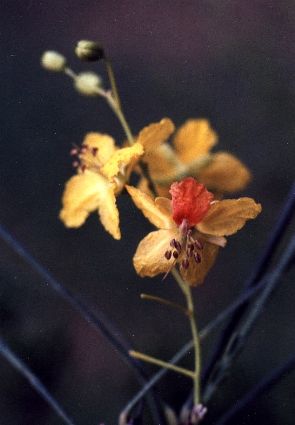Retama
by Valerie (May 27, 2001)
 There is a strange plant that grows in this area, which is sometimes used as an ornamental tree. Its principal common name is Jerusalem thorn (Parkinsonia aculeata), even though it is a Mexican native; and it goes by the name of retama here. There is even a new racetrack near San Antonio called "Retama Park." Other names include horse-bean and Mexican paloverde.
There is a strange plant that grows in this area, which is sometimes used as an ornamental tree. Its principal common name is Jerusalem thorn (Parkinsonia aculeata), even though it is a Mexican native; and it goes by the name of retama here. There is even a new racetrack near San Antonio called "Retama Park." Other names include horse-bean and Mexican paloverde.
I first saw these low, sprawling trees growing on a hillside along a highway. They give a new meaning to the "spiny forest" concept of Madagascar. These trees are covered with thorns. We have a pair of them at the end of our driveway, where nothing else would grow when we first moved in. The trees are now the centerpieces for two small xeriscaped gardens that include agaves, kalanchoes, cactus, sedum, and silver Texas sage. They are very well adapted to conditions of drought and intense sun. When they get enough water, they produce two rows of tiny leaves along flexible stems. These stems, as well as the bark, are green so the trees don't really need the leaves for photosynthesis. In the spring and periodically throughout the summer, retama produce beautiful yellow blossoms. These then rain down so that the ground below is covered in yellow. During drought, the leaves fall off, and during the winter, the leaf stems are dropped. They resemble hay strewn about the lawn and are useful for protecting delicate succulents from freezes.
The seeds are large, smooth, and oval-shaped. They germinate readily and the tenacious little seedlings are very hardy. This explains why they often cover large areas and grow thickly. Retama is also very fast growing, with long, brittle branches that break off easily. The normal habit of the tree is to have multiple stems, but early pruning when the plant is young can produce a normal looking tree. Even though this is not an official name, we usually refer to the retama as "dragon trees," a name which aptly describes their lethal thorns, bright green bark, and tiny scale-like leaves. It is also a good description of their character, as pruning these sprawling monsters is not for the faint of heart. I inevitably get speared by at least one or two spines every time, and our city brush collection will not remove the piled up branches because of the thorns.
One of the redeeming qualities of retama is the way it attracts wildlife. I've often seen green anoles, spiders and praying mantises in the trees. The mantises frequently lay their eggs on the undersides of the branches. When the flowers are blooming, there are swarms of bees, flies and butterflies. This year, an unusual thing happened. Just as the leaves and flower buds were forming, we had dozens of red admiral butterflies fluttering around the branches. I couldn't make out what they were doing, but they often used their proboscises on the leaf stems. We soon discovered what they had been doing: laying eggs. Although I could never see the caterpillars, very soon all the leaves and buds were eaten and there was a green carpet of caterpillar droppings below the trees. The insects evidently were rather tasty to birds, as grackles spent quite a bit of time trying to land on the extremely slender branch tips (with amusing results) to pick off the little morsels. Although we missed the spectacular show of yellow blossoms this spring, all the butterflies made up for it, and there is always a chance that the retama will bloom later this summer. |
